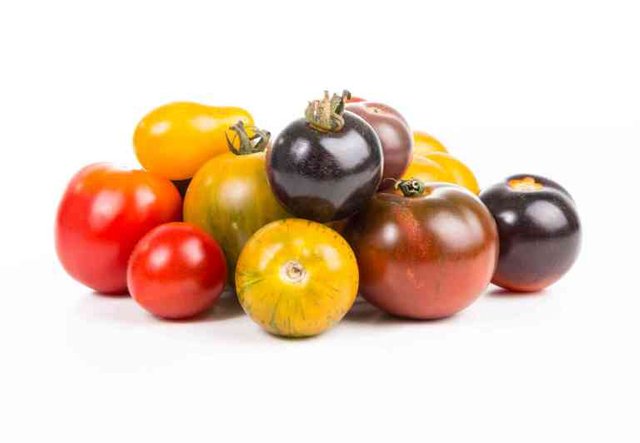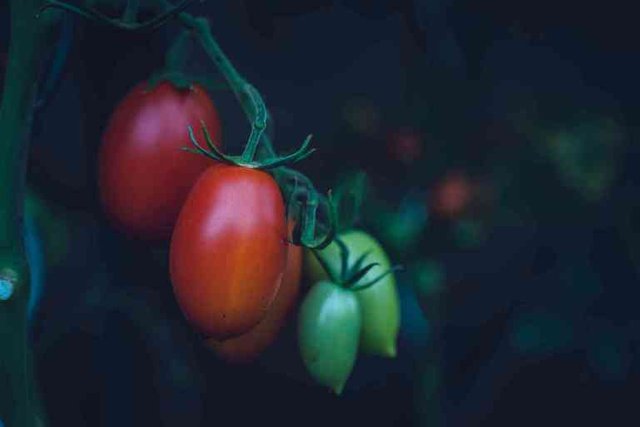
The benefits of tomatoes are studied regularly, and some studies highlight the virtues of this fruit, which is often considered a vegetable.
Tomato (Solanum lycopersicum L.) is the berry of a Solanaceae plant native to South America. It has become for centuries a classic garden and vegetable gardens around the world.
Among their virtues, tomatoes are the main dietary source of lycopene, an antioxidant, which has many health benefits, including a reduced risk of heart disease and cancer.
Tomatoes are also an excellent source of vitamin C, potassium, folic acid and vitamin K.

Generally, tomatoes are red when ripe, but the many existing varieties can offer a range of different shapes, flavors and colors, including green, yellow, orange, red, dark red, black and purple tomatoes.
This point on the color of tomatoes is interesting. This is reported by researchers who compared levels of antioxidants in tomatoes of different colors.

Indeed, the results of a study published in January 2019 in the Journal of the American Society for Horticultural Science show higher levels of specific antioxidants depending on the particular coloring of tomatoes.
The researchers reveal that the genotypes could be used either directly in the diet or in breeding programs to recover larger quantities of functional compounds such as carotenoids, tocopherols, anthocyanins and vitamin C.

TOMATOES, COLORS AND ANTIOXIDANTS
Natural antioxidants have attracted great interest in recent years because of their recognizable health benefits, and tomatoes are among the most popular fruits and vegetables.
This tomato study clarified different levels of antioxidants by focusing on eight tomato genotypes containing different colored fruits.
The authors demonstrate that specific antioxidants are associated with certain tomato colors
The team of researchers investigated and assessed the variation in carotenoid, polyphenol and tocopherol content among selected hybrid and indigenous tomato lines, as well as fruit antioxidant testing.
In addition, the expression of genes related to the metabolism of isoprenoids and two transcription factors related to pigmentation was determined.

TOMATOES ARE A MAJOR SOURCE OF ANTIOXIDANTS IN A DIET
According to the researchers, tomatoes are the main source of antioxidants in the diet.
"We know little about their content and their regulation in genotypes of different colors, shapes and sizes. The association of higher levels of specific antioxidants with particular coloring of the fruit suggests a balance between these compounds, "explain the researchers.
Tomatoes are an excellent source of antioxidants and contribute significantly to human health because of their anti-inflammatory, anti-allergenic and antithrombotic properties.

In this way, the results of this study support the direct marketing of tomatoes of different colors, or the use of their genotypes in breeding programs to increase antioxidant levels among existing cultivars.
Note that carotenoids and tocopherols are among the main lipophilic antioxidants found in tomatoes. Also, "polyphenols are powerful antioxidants that have interfered with the initiation, promotion and progression of cancer. The main polyphenols of tomato are hydroxycinnamic acids, flavanones, flavonols and anthocyanins, "the authors add.
"In recent years, the biosynthetic pathways of carotenoid, tocopherol and chlorophyll have been studied because of their importance for understanding the regulatory dialogue that contributes to the nutritional quality of tomato fruit," the researchers said.

This study, which was conducted in Mexico at a center for tomato diversification and domestication, was able to study a wide range of native genotypes with fruits of different colors, shapes and sizes.
These genotypes could be integrated into breeding programs to increase the nutraceutical properties of commercial cultivars and recover antioxidant compounds lost during the breeding process.
Finally, all the genotypes used in this study were part of the Mexican plant genetic resources network.
The study lines, native and hybrid, were planted according to a completely randomized block design with three replicates and each experimental unit included 10 plants.

Until researchers use genotypes directly in the diet for future applications, if you want to enjoy the benefits of tomatoes on your health, it is advisable to consume local tomatoes (natural maximum or organic) of all colors.
This way, you will be able to assimilate larger quantities of essential functional compounds such as carotenoids, tocopherols, anthocyanins and vitamin C, which vary according to the color of the tomatoes.

To guarantee the antioxidant content of tomatoes, it is recommended to consume the different varieties of cooked raw tomatoes (salads, juices), and taking care not to store them below 12.5 ° C, mainly to preserve the sensory quality.